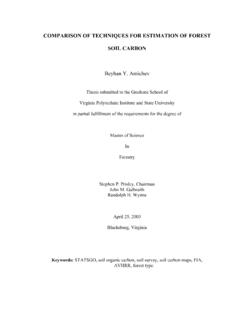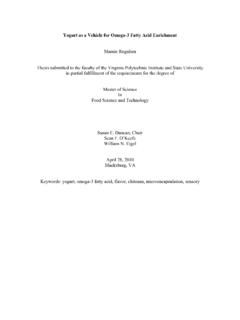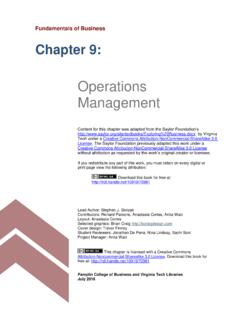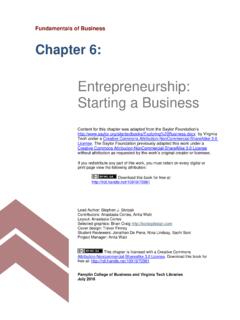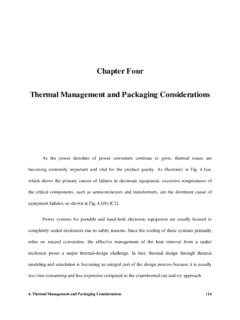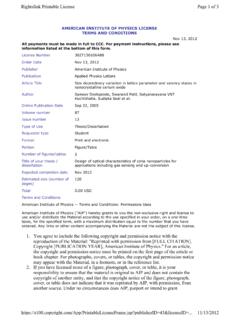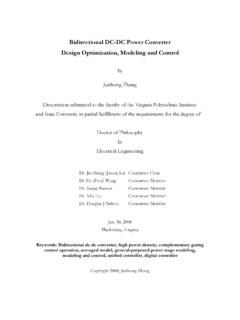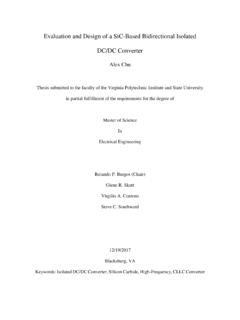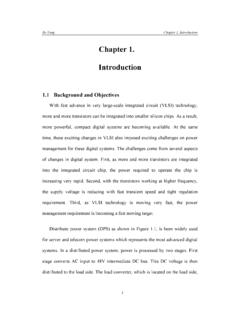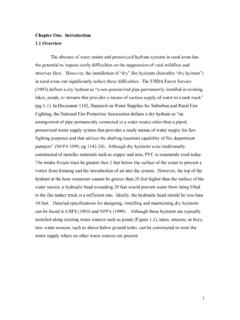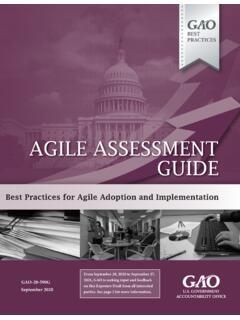Transcription of 1. Introduction and Scope of Research - Virginia Tech
1 1. Introduction and Scope of IntroductionThe increasing globalization of industry is causing an acceleration in the pace of productchange (Salomone, 1995) The ability to introduce new products faster, more frequently, and ofhigher quality is a distinct competitive advantage (Liker, Sobek, Ward and Cristiano, 1996).Bringing new products to market faster has become a strategic imperative in many markets(Zirger and Hartley, 1996). Many companies are adapting agile manufacturing practices. Agilemanufacturing refers to the capability to quickly go from a set of novel customer requirements toa quality, finished product (Kleiner, 1997).
2 Productivity, the dominant competitive paradigmprior to the late 1970 s, has been replaced by quality (Haddad, 1996). Effective productdevelopment minimizes the resources (people, money, and time) required to provide anappropriate mix of product features, performance, quality, price, and availability to customers(Zirger and Hartley, 1996).To be more competitive, many organizations are experimenting with a productdevelopment strategy called concurrent engineering (CE) (Salomone, 1995). CE is generallyrecognized as the practice of concurrently designing both the product and its downstreamproduction and support processes in the early stages of design.
3 In a concurrent engineeringprocess, the downstream functions ( , manufacturing and support) are able to influence , organizations have used a sequential engineering (SE) approach in which theproduct is designed and then its downstream manufacturing and support processes are a sequential engineering process, downsteam functions have to influence product or systemdesign through change order is believed to shorten product development time, increase product and process quality,and lower the cost of production (King and Majchrzak, 1996; Parsaei and Sullivan, 1993; Winner,Pennell, Bertrand and Slusarczuk, 1988).
4 CE represents one of the most recent significant trendsin new product development (Gerwin and Susman, 1996).The effect of engineering methodology (EM), sequential or concurrent, on performance,time, cost, and other process variables is a major aspect of this use of multidisciplinary or cross-functional teams is a major tenet of CE (Winner , 1988). Using a team consisting of members representing all of the key functionalorganizations, especially marketing, engineering and manufacturing, has been identified withreduced development time (Zirger and Hartley, 1996).
5 According to Zirger and Hartley (1996),teams, as compared to individuals, decrease time by facilitating communication, cross-functionalcooperation and increasing goal congruence among the functional organizations. However, groupdynamics Research has found that as group size increases, interaction becomes more complex andthe group may have difficulty reaching consensus (Shaw, 1981).The terms team, group, and working group appear in the literature in a variety of authors differentiate between the terms. For example, Katzenbach and Smith in theWisdom of Teams defined a team as follows (Katzenbach and Smith, 1993, page 45): A team is a small number of people with complementary skills who are committed to acommon purpose, performance goals, and approach for which they hold themselvesmutually accountable.
6 They then stated that working groups are not teams because there is no significant incrementalperformance need or opportunity that would require the group to become a team. Katezenbackand Smith (1993) further refined the concept of teams into pseudo-teams, potential teams, realteams, and high-performance teams. This Research , however, did not differentiate betweenvarious types of groups and teams. Therefore, the terms team, group, and working group will beused interchangeably effect of group size (GS), specifically small three-person groups and large six-persongroups, on performance, time, cost, and other process variables is another major aspect of tools are being developed to increase the concurrency of design by allowing teamsof designers to remotely communicate on a network and share information in a common data base(Cleetus and Reddy, 1992).
7 The importance of the development of tools to enable CE can beseen by the level of federal Research funding allocated to CE tool development: $60 million spentby Defense Advanced Research Projects Agency over a three-year period (Reddy, Wood andCleetus, 1991). However, in some product classes, the use of CE tools has slowed thedevelopment process (King and Majchrzak, 1996).Computer-supported cooperative work (CSCW) is a new field of Research that drawstogether social scientists with system builders interested in developing a more-refinedunderstanding of how people work together and make decisions (Galegher and Kraut, 1990).
8 CSCW is a computer-assisted coordinated activity carried out by a group of collaboratingindividuals to solve problems and communicate (Baecker, 1993). The multi-user softwaresupporting CSCW is called groupware. Herein, the term CSCW will be used when referring totheoretical issues. Groupware will be used when referring to the software used in this ranks with innovation in the importance in the engineering design process(Siddall, 1972). Therefore, computer-supported cooperative work technology holds greatpotential for improving the design effect of computer-supported cooperative work technology (CSCW) on performance,time, cost, and other process variables is another major aspect of this Research .
9 New informationtechnologies like CSCW have created a need to measure and evaluate system performancecomprehensively. Kleiner (1997) proposed a generalizable framework for understanding,measuring, and evaluating performance within an information-based management theoretical basis of this Research is sociotechnical systems theory. Sociotechnicalsystems (STS) theory suggests that personnel variables, like group size, must be considered alongwith technological variables, like the use of computer decision-making tools, to optimize theengineering design process.
10 The top-down sociotechnical engineering systems approach to thedesign of organizations, work systems, jobs, and related human-machine, user-system, andhuman-environment interfaces is called macroergonomics (Hendrick, 1986; 1991; 1995).This experimental Research with field confirmation adoped a sociotechnical systems andmacroergonomic view of the engineering design process. This means that the impact of bothtechnological and personnel variables in the design of an engineering organization are following independent variables, each with two levels, were considered by this Research :Engineering Design Methodology (EM): concurrent versus sequential Size (GS): large (six person) versus small (three person) Cooperative Work (CSCW): using versus not using computer-supported cooperative work technology ( , manual).
